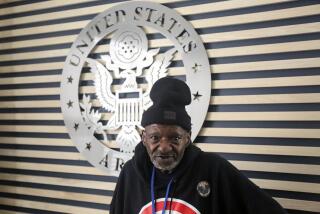Relatives Seek Help : War’s Missing: Doubts That Won’t Go Away
WASHINGTON — As soon as Bill Callahan had recovered enough from Vietnam War injuries to get out of his wheelchair, he started to walk in February from his Inverness, Fla., home to New York to remind Americans that 2,477 service personnel are still missing in Southeast Asia.
“They sent me to Vietnam to fight for something I did not understand,” Callahan said recently. “Now I am fighting for something that I do understand. I have 14 friends who are on the wall”--the black marble Vietnam Memorial listing the names of the 58,022 war dead.
Callahan paused in his hike to work briefly at the green tent headquarters of the Veterans Vigil of Honor, where former fighting men have maintained an around-the-clock watch on a small slice of parkland near the Vietnam Memorial since Dec. 24, 1982, to dramatize the still unsettled fate of the Americans missing in action.
Eleven years after the final withdrawal of U.S. ground forces from Vietnam and a decade after the fall of Saigon, the MIA issue remains one of the most painful loose ends of the conflict.
Search Continues
The National League of Families, a nonprofit, nonpartisan group of close relatives of current and past U.S. prisoners and MIAs, was organized in 1970 and has lobbied actively to keep up the search for the missing.
Legally, all but one of the 2,477 MIAs are classified as “presumed dead” and are included among those listed as killed in the nation’s longest war.
But as long as their remains have not been recovered and identified, their relatives argue that there is a slim chance that some are still alive, perhaps postwar prisoners of the Communist Vietnamese government.
Like many MIA relatives, Californian Gladys Fleckenstein, whose son, Lt. Cmdr. Larry Stevens, was shot down outside Da Nang in 1969, said she has had the same dream for 16 years: Her son is alive and pleading for help.
“He’s always there asking for my help, always,” said Fleckenstein, a Big Bear Lake resident. “In some ways, I hope I’m right, and in some, I don’t, because of what they must be going through over there.”
Prisoner in Laos?
The only serviceman not declared legally dead is Air Force Capt. Charles Shelton, who was shot down in Laos 20 years ago and was believed to have been taken prisoner by the Pathet Lao. As a symbol of all those not yet accounted for, the Pentagon still lists him as a prisoner of war. Shelton has been promoted to colonel over the years and still draws pay as if he were on active duty.
The former soldiers at the Vigil of Honor have no doubts that some MIAs have survived. A sign at the encampment proclaims, “Our Missing Defenders Are Alive--We Want Them Back.” The six veterans who regularly conduct the vigil will tell anyone who asks that there have been 450 “first-hand sightings”--instances in which witnesses claimed to have seen U.S. servicemen--since 1982.
A Pentagon spokesman, Maj. Keith Schneider, said that the U.S. government tries to check out all reports in hopes of finding some men still alive. “We operate on the assumption that some could be there,” Schneider said. “This assumption results from live sighting reports.”
Nevertheless, he said, “we have been unable to prove that any Americans are still detained against their will, (although) the evidence does not preclude the possibility.”
Prisoner Accord
Under the Paris peace agreement signed by the United States, South Vietnam, North Vietnam and the Viet Cong in January, 1973, all parties promised to return prisoners of war after the withdrawal of U.S. forces from Vietnam. Between Feb. 12 and April 1, 1973, the North Vietnamese and the Viet Cong returned 591 American prisoners. But that left almost 2,600 unaccounted for.
In the 11 years that have passed since, the Communist regime has returned bodies or otherwise accounted for enough individuals to bring the MIA total down to its present level.
Just last month, the Hanoi government handed over what it said were the bodies of five Americans. But the Defense Department earlier this month said that, as a result of three weeks of intensive tests, it was able to positively identify the remains as those of six former fighting men.
President Reagan announced last July that Laos had agreed to allow U.S. officials to excavate the crash site where a C-130 gunship went down. The President said the agreement indicated Laos had “gained a greater understanding of the importance to us of the POW/MIA issue.” About 600 of the MIAs were lost in Laos.
Praise for Laos
The excavation was conducted in February, with U.S. personnel joining Laotian soldiers in searching for bodies. The remains of 13 presumed MIAs were found and flown to Hawaii for examination and identification at the military laboratory there. Although the U.S. government praised the Laotian government for its action, there have been no subsequent searches.
Vietnam has refused to permit similar cooperative excavation efforts, insisting that there can be no search until relations with the United States are normalized. But the United States says that it will not extend diplomatic relations to Hanoi unless the Vietnamese make substantial progress in accounting for the MIAs.
Since they began the encampment 28 months ago, the veterans at the Vigil of Honor have collected the signatures of more than 10 million Washington visitors on petitions urging the return of MIAs.
“We send the petitions to Hanoi in bundles,” David Wuntke, one of the vigil’s regulars, said. “I believe that has an impact.”
Times staff writer Kim Murphy in Orange County contributed to this story.
More to Read
Sign up for Essential California
The most important California stories and recommendations in your inbox every morning.
You may occasionally receive promotional content from the Los Angeles Times.










